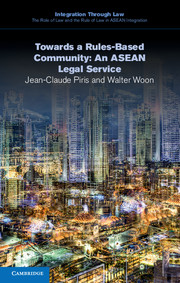2 - Towards an ASEAN community
Published online by Cambridge University Press: 05 March 2015
Summary
According to the EPG on the ASEAN Charter, the ultimate end point is the creation of an ASEAN Union. What form this is to take was not spelled out, and indeed there has been no official mention of this subsequent to the presentation of the Report of the Eminent Persons' Group. The aim of creating an ASEAN Community remains alive, however. The target date is 2015, as decided at the Twelfth ASEAN Summit in Cebu in January 2007. Whether it is a Union or Community to be formed, clearly much more has to be done to foster the rules-based culture that closer integration requires. There are two essential elements: first, there has to be an effective mechanism for settling disagreements among the member states that goes beyond mere political patching; secondly, there must be a formal system for promulgating, interpreting and enforcing the rules that are necessary for the creation of a cohesive ASEAN Community. Logically, the creation of rules should come first; but in the ASEAN context there are quite enough rules, the principal problem being enforcement. ASEAN lacks a culture of keeping to the grandiose plans of action, blueprints and roadmaps that each Summit creates. This must change if the ambition to create an ASEAN Community based on the rule of law is to succeed.
To appreciate the need for a proper legal service, it is necessary to examine the current reality as far as rule-makingand dispute settlement are concerned. Much of what follows is based on the experience of one of the authors and discussion with diplomats and officials involved in ASEAN activities.
The current reality
2.1.1 The making of rules
A rules-based organisation must have some means for making rules. The current method depends largely, if not exclusively, on the member states themselves. The rules that bind ASEAN member states are to be found in the many treaties, agreements, memoranda of understanding and protocols that are produced after the ASEAN Summits and sectoral meetings in the course of a year.
- Type
- Chapter
- Information
- Towards a Rules-Based Community: An ASEAN Legal Service , pp. 65 - 112Publisher: Cambridge University PressPrint publication year: 2015



